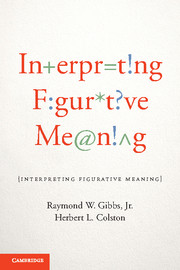Book contents
- Frontmatter
- Contents
- 1 Introduction
- 2 Identifying Figurative Language
- 3 Models of Figurative Language Comprehension
- 4 Interpreting Specific Figures of Speech
- 5 Indeterminacy in Figurative Language Experience
- 6 Factors Shaping Figurative Meaning Interpretation
- 7 Broadening the Scope of Figurative Language Studies
- References
- Index
5 - Indeterminacy in Figurative Language Experience
Published online by Cambridge University Press: 05 June 2012
- Frontmatter
- Contents
- 1 Introduction
- 2 Identifying Figurative Language
- 3 Models of Figurative Language Comprehension
- 4 Interpreting Specific Figures of Speech
- 5 Indeterminacy in Figurative Language Experience
- 6 Factors Shaping Figurative Meaning Interpretation
- 7 Broadening the Scope of Figurative Language Studies
- References
- Index
Summary
A cartoon in The New Yorker magazine (August 25, 2008, p. 78) shows a baseball player lying on a psychiatrist's couch, dressed in a uniform and holding a baseball glove in one hand, as a very Freudian looking therapist sits behind taking notes. The caption reads, “My life is a powerful blast to center field easily snagged on the warning track.” Readers will need to know something about the game of baseball to understand and appreciate some of the complex meanings evoked by this cartoon. People must understand that a batter can initially appear to hit the ball very hard and possibly far and still have the ball slow down and be easily caught by a fielder before it goes over the homerun wall (where the “warning track” indicates that the fielder is coming close to the wall or fence). Moreover, there is something wonderfully allegorical about this poor player confessing his plight to a psychiatrist, and seeing his life as just a routine out (e.g., the ball being “easily snagged”) in the game of life, despite early appearances of great promise (e.g., “a powerful blast”). Most of us feel empathy for this person because we too have had moments in life where actions we initiate start well but end in inglorious failure.
When reading this cartoon, we not only engage in cognitive work to understand something about what the metaphorical statement may mean, but also quickly experience a range of thoughts, attitudes, and feelings (including humor) that make the cartoon, and metaphor, stand out and appear special. Figurative language of all types, including metaphor, is heralded for its ability to suggest meanings, attitudes, and emotions that seem hard to vividly evoke using nonfigurative language. Although conventional forms of figuration are often presumed to be less evocative of complex meanings and emotions than more creative, poetic tropes, people may still employ clichéd metaphors, ironies, idioms, proverbs, and so on, because they too accomplish various social and pragmatic goals in an easily understood medium.
- Type
- Chapter
- Information
- Interpreting Figurative Meaning , pp. 192 - 259Publisher: Cambridge University PressPrint publication year: 2012



